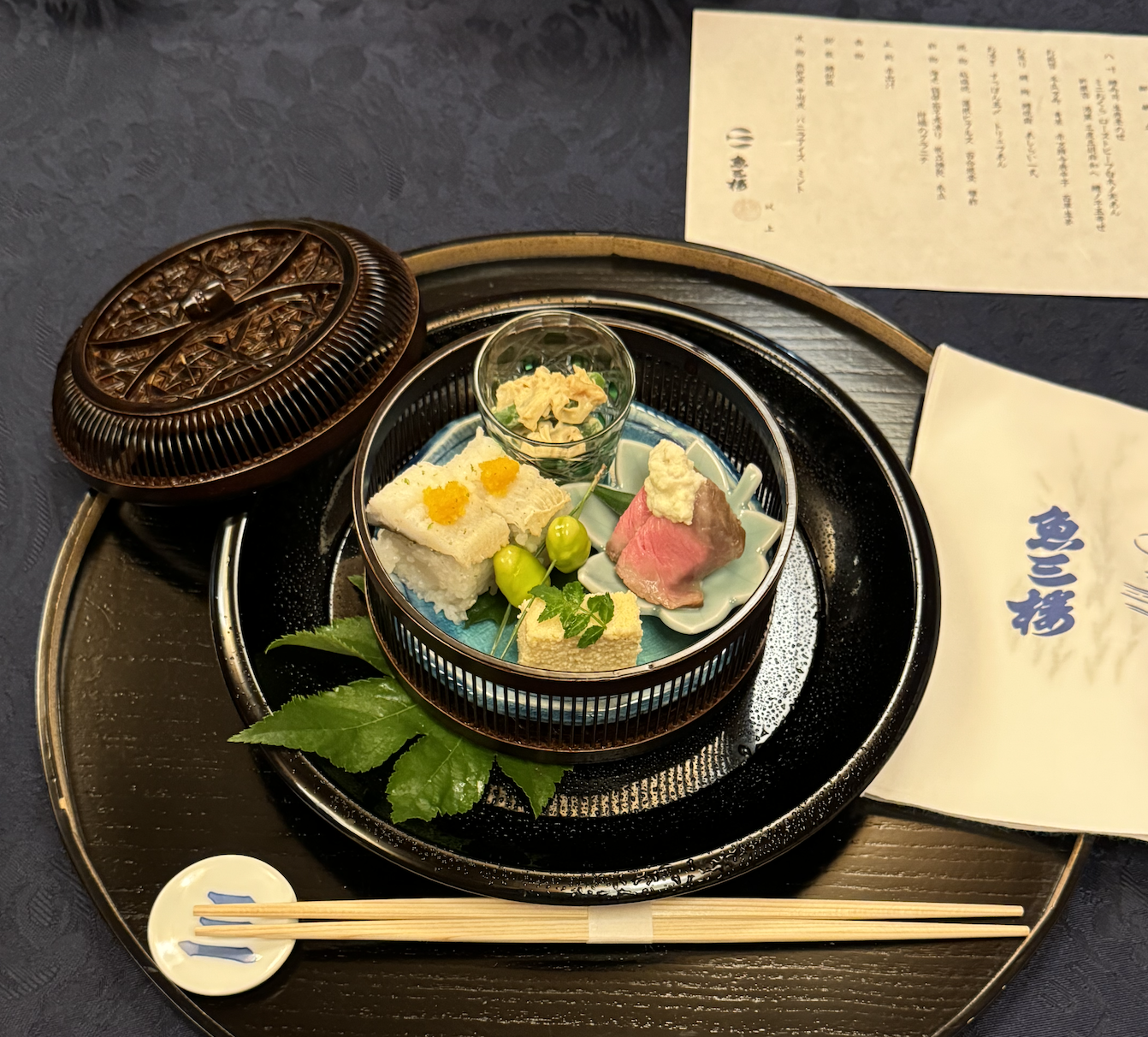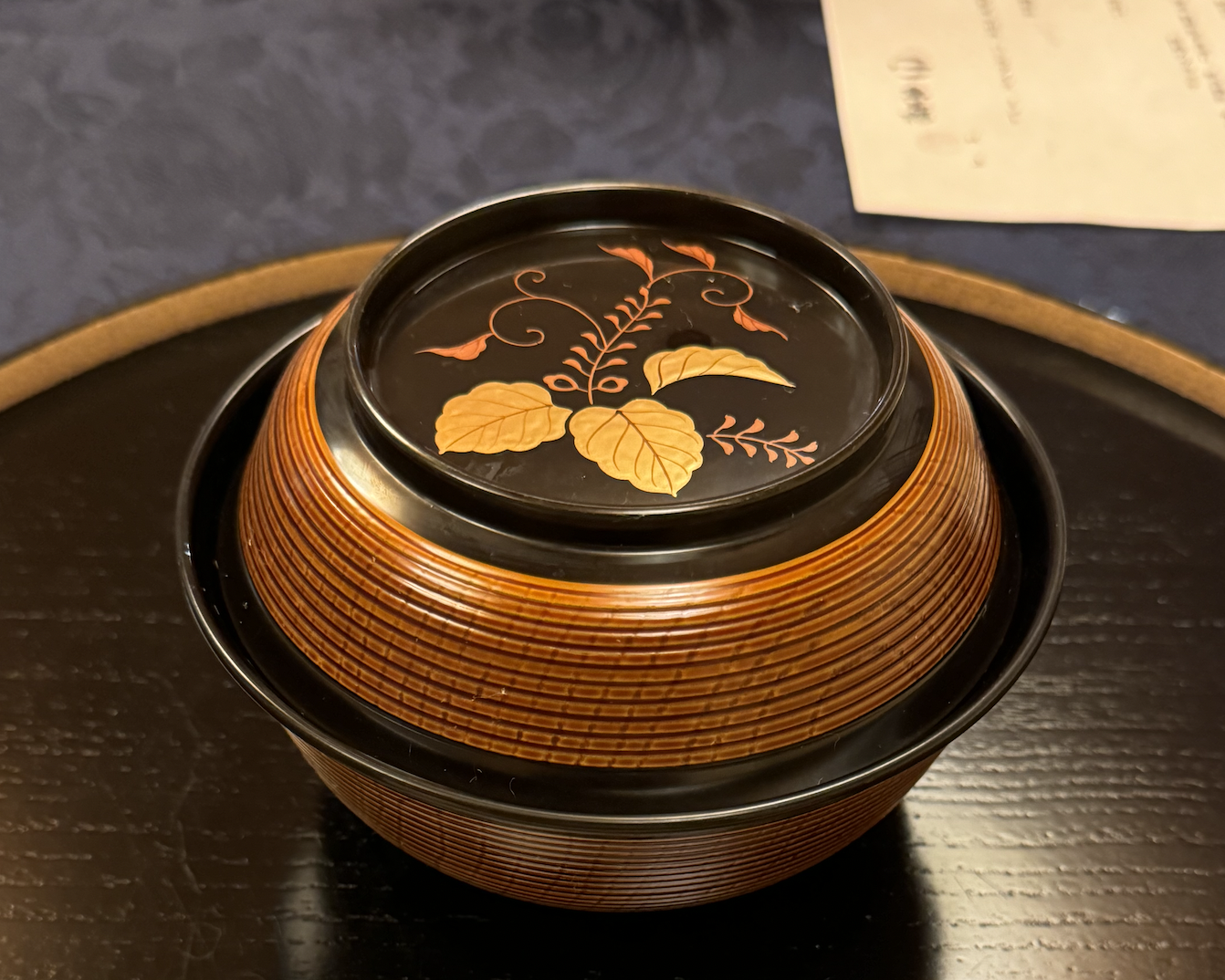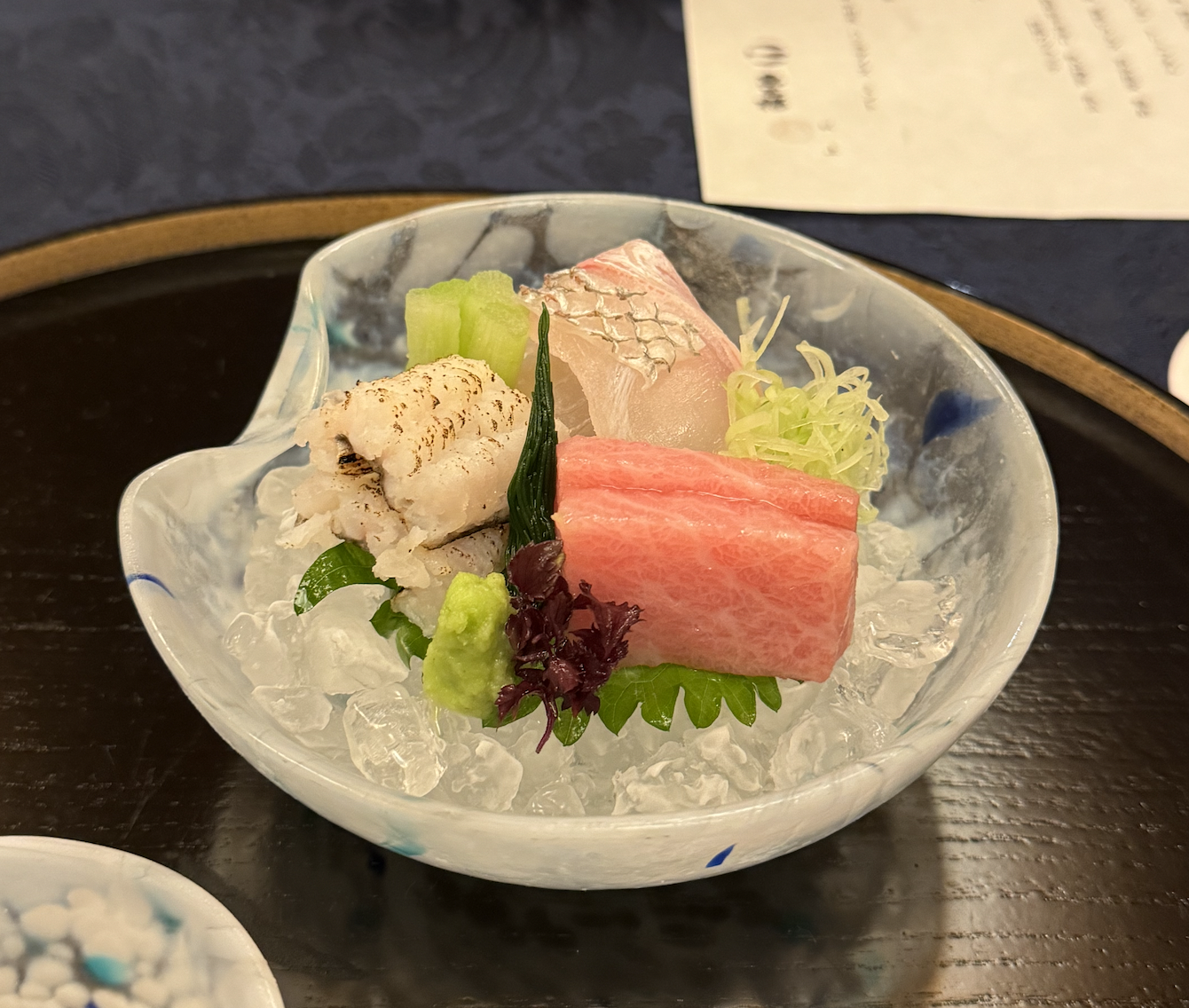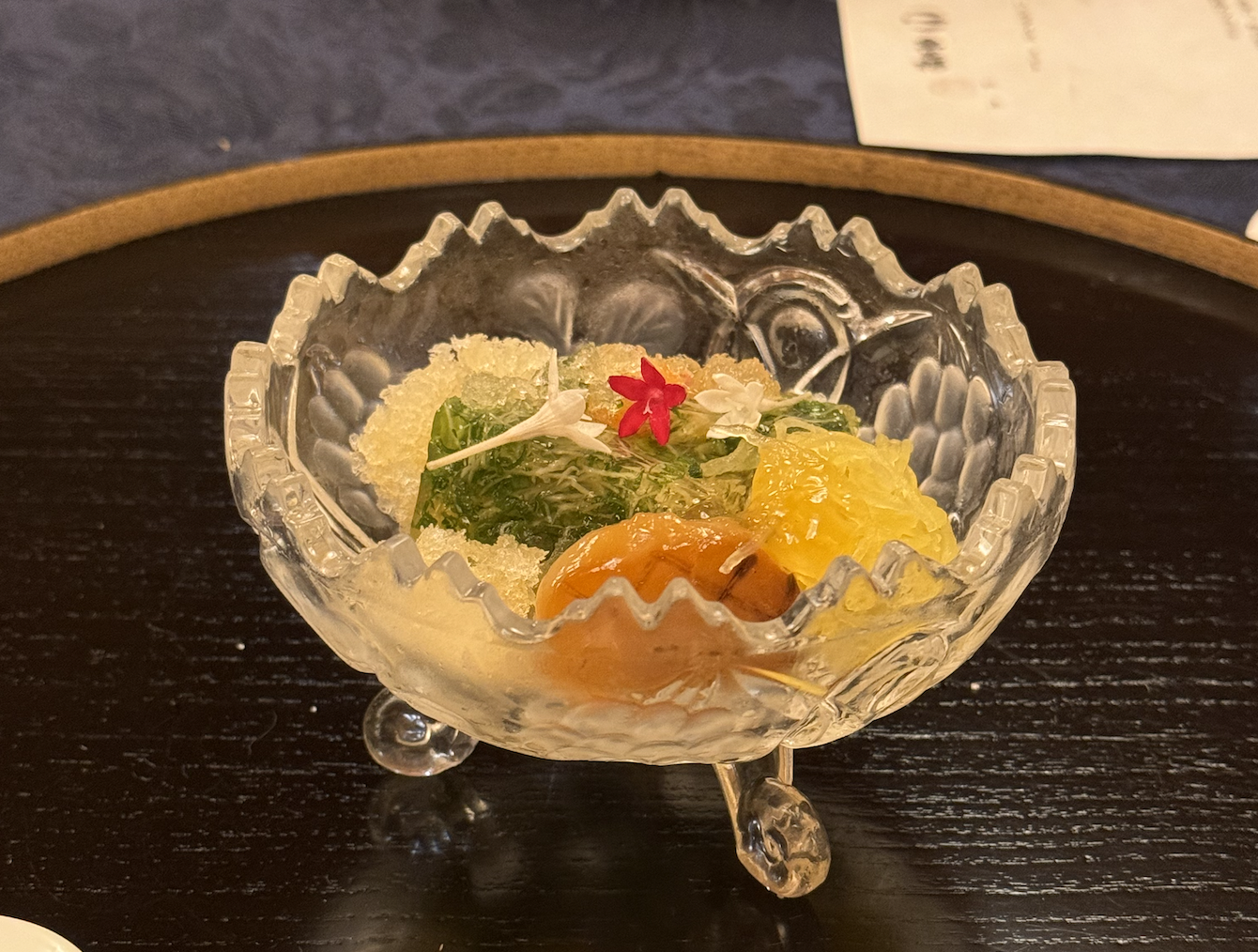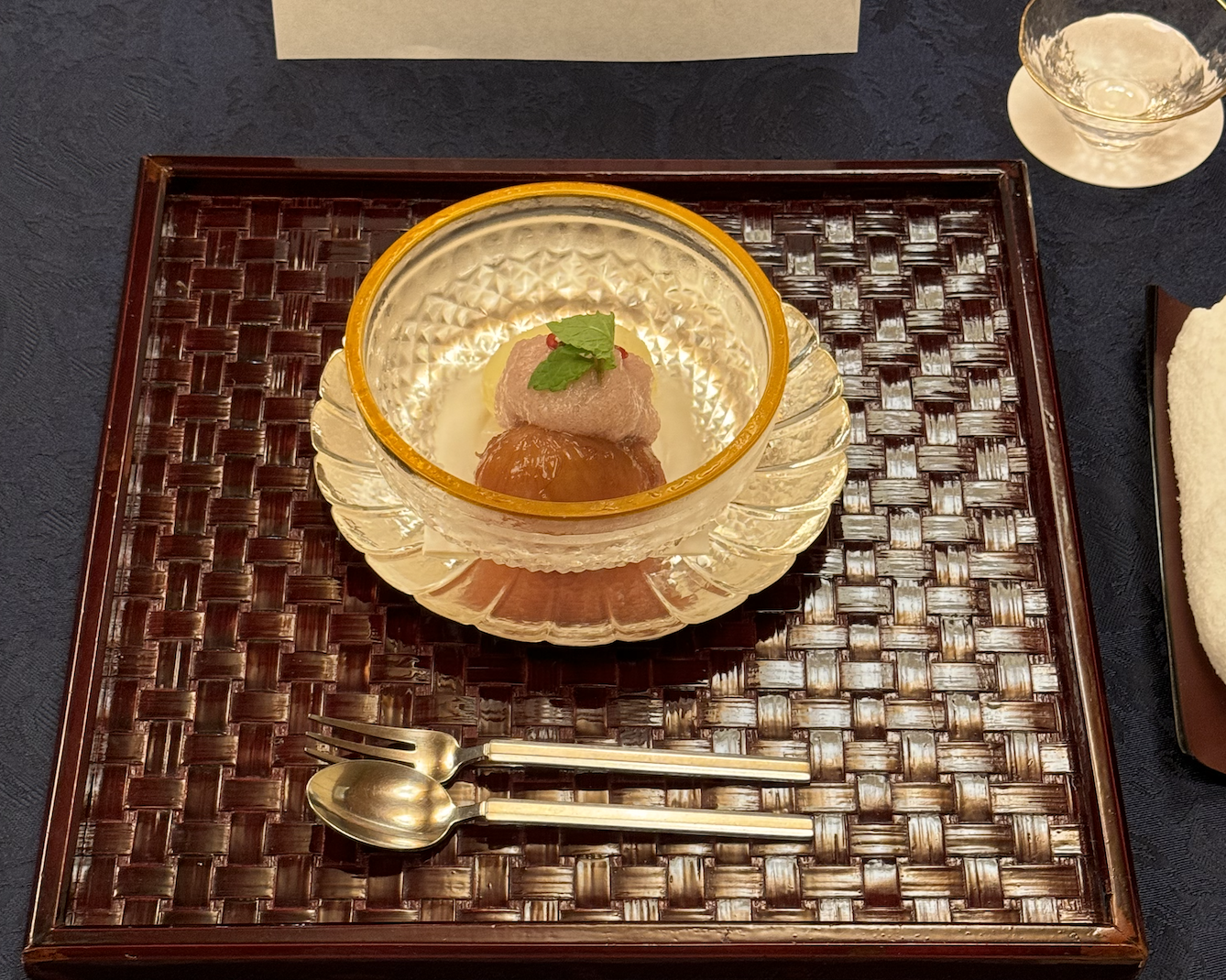Following Seasons: Food Wares in Kaiseki Dining
As explored in previous articles, kaiseki dining is all about following the seasons with a diligent approach to time. Whilst ingredients certainly form an indispensable part of the multi-course meal, the vessels also contribute profoundly to the embodiment of seasonality and atmosphere, expressing the beauty of nature. Displaying a range of forms and materials, these food wares impact our dining experience through sight, touch, and even sound.
Before the chilly months signalling the end of the year arrive, Uosaburo’s late August kaiseki course offers the perfect opportunity to indulge in a final celebration of a prolonged summer, where natural motifs, cooling colours, and ethereal shapes intertwine.
Harmony of Multiplication
What is usually presented before our eyes in a meal? A plate, utensils, a cup for drinks – perhaps sometimes two plates layered together, the charger plate below contributing to the overall tablescape. Yet, in a full kaiseki course that starts with hassun, seasonal small dishes often containing one kind of sushi, the layout is much more elaborate and diverse.
The entire course is presented upon a round, black lacquered dish with shallow edges, which captures and reflects light with a soft glow. A freshly picked leaf sits underneath a lidded box displaying openwork and overlapping carved bamboo leaves – a real piece of balmy summer playfully blending with artificial craftsmanship. Touching and lifting the lid, as the surprised sensation of the extremely lightweight material fades away, a dazzling array of small plates conjures up a visual feast for the eye.
A ceramic plate in turquoise glaze paves a glamorous vibrancy to the setup. The burst of blue and green glazes, resulting from uncontrollable chemical reactions inside the kiln, explodes from its centre like an exhilarating fountain, carrying conger eel sushi and green ginkgo nuts. Upon it, a glass cup and a maple leaf-shaped celadon dish hold traditional bean paste and roasted beef.
Despite multiple layers of stacking, the display of vessels appears in harmony with one another, with the food, and with nature itself. All colours are united under the refreshing scheme of cool celadon and sky blue. The dark shimmer of the hassun dish contrasts with the smaller dishes, bringing out their hues and highlighting their delicious content. As the colour scheme offers a visual revitalising effect in humid summer, a sense of airiness and wind is achieved through the intricate openwork of the box, which, as it partially obscures the dishes, also draws upon the concept of yūgen – mysterious beauty.
Additionally, it is worth noting that despite being served as a set, all the plates, dishes and cups are individually picked and curated. They illustrate a close observation of the seasonal climate, followed by the extraction of specific elements such as vigour and ventilation, which form a criterion for food ware selection. In light of this, one might even argue that kaiseki is not too far away from fine art curation and exhibitions, bridging between culinary traditions and artistic enterprises with dedicated attention to the smallest details.
Variation
We have discussed the compound effects of beautiful vessels in a single course, but since kaiseki is a multi-course menu, these sensorial wares must be considered within a flowing dining sequence.
After the hassun, wan-mori is served. This is a simmered dish with clear broth, which creates a lovely interlude of warmth and subtle umami. At Uosaburo, the wan-mori is contained within a wooden lacquered soup bowl with a lid. The smooth, black lacquered surface is adorned with coils of red and brown patterns, their slightly undulating curves giving a texture similar to bamboo mats used for enjoying the cool in midsummer. On the top of the lid, a simplified, graceful motif of golden grape vines curls into one’s palm as the cover is removed, a reminder of the upcoming harvest season.
Black colour absorbs heat, making it suitable as a vessel serving soup, transmitting the warm temperature into the hands holding it. The polished lacquer furthermore mimics how the broth is drunk smoothly down the throat. In essence, the bowl helps to craft a gentle, mellow atmosphere that aligns with the food and the gradually deepening summer night.
Yet, the following sashimi plate quickly changes the mood.
Inside an irregularly shaped glass bowl, pink tuna, sea bream and grilled conger eel are surrounded by shiso leaves and cucumber slices on crushed ice. Made from glass, the bowl has a matte surface that looks like mist rising across windows when there is a big difference between temperature and moisture indoors and outdoors in the sultry summer months. Blobs of white and ultramarine slide over the container in a manner that recalls Georgia O’Keeffe’s expressionist Sky Above Clouds paintings, carefree and exuberant.
The two smaller dishes for soy sauce and condiments repeat the same formula: one shares the design with the sashimi plate, the other a blue-and-white porcelain piece.
A joyous metamorphosis occurs between the two courses. Warmth becomes coolness, lacquer transforms into glass. It feels like stepping into the shade or a quick dip into the ocean, which resonates ideally with the thinly sliced raw fish. From aromatic broth to delicate sashimi, the vessels used here are essential to this seamless and elegant transition, playing with textural and perceptible variations to bring ingenuity and different seasonal elements to the table.
Crystal Summer
No summer meal is complete without glassware. Clear, icy, and malleable into all shapes and forms, they lighten up the visual and tactile rhythm of the meal. Apart from the sashimi dish, various other courses in Uosaburo’s late August kaiseki dinner use glass in their presentation.
Glass, or garasu, is not indigenous to Japan but arrived by trade with China and the Korean peninsula around the 3rd century. The art of glassmaking as a craft flourished during the Edo period (1603-1868), particularly with the introduction of European techniques, producing celebrated glassworks like Edo kiriko, delicate cut glass in a variety of brilliant geometric patterns. Today, in modern kaiseki dining, glass vessels are employed for their visual sparkle and clarity, as well as connotations of coolness and refinement.
Take the su-zakana course as an example. A small dish of vinegared vegetables and ice used to cleanse the palate, it is plated in a decorative glass footed bowl. The carved patterns of grapes and petals create a flourishing image of natural produce, interacting with the vegetables inside. Their slightly matte texture contrasts with the overall smooth edge of the bowl, which reflects and scatters light in varying directions. Almost shining against the black tabletop, the glassware introduces a refreshing chill before the first bite of the food.
Similarly, for dessert, house-made ice cream and poached fig are placed together in a glass bowl patterned with faceted starbursts. A golden rim outlines a circle that highlights the chilled delicacies, whilst a silver, floral-shaped plate at the bottom amplifies the reflective effect of glass and metal combined, allowing light to dance across these surfaces. The glass bowl, hence, becomes a fleeting metaphor of rippling water, summer breeze, or even the luminous moonlight draping over the world.
Paired with a silver spoon and fork, the utensils generate a symphony of bright, ringing chimes as they slightly scrape against the glass. The crystalline sound happily announces the arrival of sweetness as the long dinner – and the summer season – slowly comes to an end.
By alerting and interacting with our senses, the food vessels in kaiseki dining offer multi-sensory appeal and establish a steady relationship between us and the seasons. Their textures, sounds, and colours bring the landscape directly to the table, reminding us that to eat is also to listen, to touch, to behold. Through them, nature does not stay outside; it rests in our hands.
